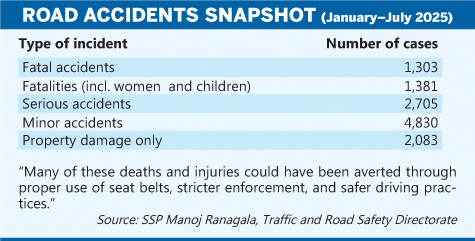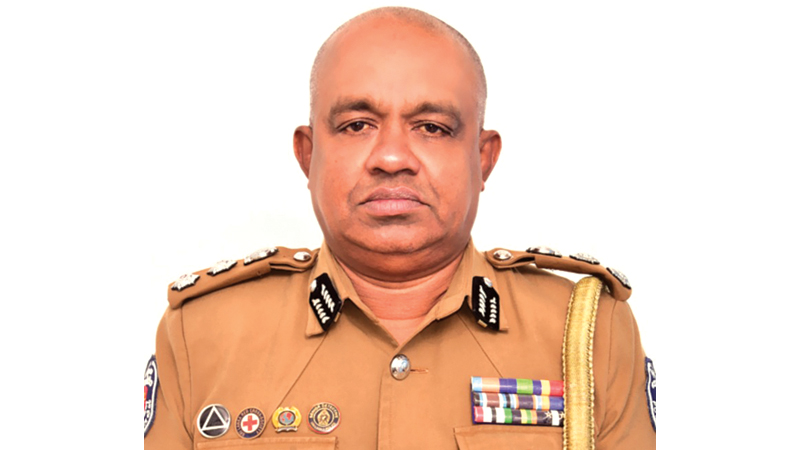In a major move to improve road safety, the National Transport Commission (NTC) has made it compulsory for all bus drivers to wear seat belts starting from July 1, while all motorists are expected to develop the habit by the end of this month.
 This renewed push includes roadside inspections, police spot checks, and public warnings issued by the Ministry of Transport. This comes amid a spike in serious accidents involving public and private transport vehicles, many of which could have been prevented with proper seat belt use.
This renewed push includes roadside inspections, police spot checks, and public warnings issued by the Ministry of Transport. This comes amid a spike in serious accidents involving public and private transport vehicles, many of which could have been prevented with proper seat belt use.
Although a Gazette notification issued in 2011 under the Motor Traffic Act made seat belts compulsory for bus drivers, enforcement has been sporadic. Now, with the number of bus-related accidents on the rise, the Government has reactivated the regulation in full force.
“A notable increase in the number of road accidents involving buses has been reported due to drivers failing to adhere to this regulation in the past,” a senior Transport Ministry official said, adding, “In view of this, the mandatory seat belt law for bus drivers is being re-implemented.”
The renewed focus on enforcement forms a part of a broader campaign by the Ministry of Transport and the Department of Motor Traffic to improve vehicle safety standards islandwide.
However, the seat belt law will not apply to motorcyclists and their pillion riders, who are required to wear helmets. It also excludes drivers of three-wheelers (tuk-tuks) from the seat belt requirement.
 Police top brass said those who drive cars, vans, lorries, trucks and public transport buses are expected to wear seat belts or they will have to face legal consequences.
Police top brass said those who drive cars, vans, lorries, trucks and public transport buses are expected to wear seat belts or they will have to face legal consequences.
From September 1, seat belt use will become mandatory for passengers travelling on Expressway buses as well as for those seated in the rear seats of light vehicles, according to Transport Minister Bimal Rathnayake.
Bus owners who fail to install and enforce the use of seat belts are being put on notice, with the Government warning that legal action will be taken against those who continue to flout the longstanding safety regulations.
Transport, Highways and Mass Media Minister Bimal Rathnayake told journalists following an inspection at the Colombo Fort Central Bus Stand that although seat belts for drivers and front-seat passengers were made mandatory from 2011 under the Motor Traffic Act, enforcement has remained patchy — particularly in the case of public transport buses and lorries.
Compliance
Urging bus operators to take immediate steps to comply, Minister Ratnayake did not mince his words.
“If you’re not willing to follow the law, find another job,” he said bluntly. “For the past three months, the Ministry has been conducting awareness programs on this issue. If bus owners have the time and money to decorate their vehicles, then they certainly have no excuse for delaying the installation of seat belts for drivers and passengers.”
Minister Rathnayake said that the safety push was not a public relations exercise but a life-saving intervention. “We’ve given ample time for compliance. No more excuses will be accepted,” he said.
The Minister also said that the authorities had received reports of a disturbing trend — some individuals and vehicle garages were concealing seat belts in an attempt to create an artificial shortage in the market.
“This is deliberate sabotage of a safety initiative. Anyone found engaged in such actions will face strict legal consequences,” he said.
The Ministry reiterated that the regulations were introduced to reduce the number of fatalities and serious injuries, particularly in accidents on the country’s Expressways. Seat belts, the Minister said, are a proven protective measure and a basic obligation under the law — not a matter of personal discretion.
Wearing seat belts has been mandatory for drivers and front-seat passengers in vehicles with English number plates since October 1, 2011. This requirement is enforced under the Motor Traffic Act. While the law has been in effect for some time, enforcement, particularly for buses and lorries, has been inconsistent. The penalty for not wearing a seat belt can include fines and, for subsequent offences, potential licence suspension.
All imported vehicles must meet safety standards outlined in the Imports and Exports (Control) Act of 1969 under the current regulations. This includes the requirement that front seats be equipped with three-point seat belts, which offer lap and shoulder restraint.
“This is how vehicles are imported — in line with mandatory safety specifications,” an official said.
Where applicable, rear passengers should be provided with at least two-point seat belts for basic protection.
In terms of passive safety features, all vehicles must also be fitted with standard airbags for the driver and front passenger to comply with import guidelines and international safety norms.
For the past few weeks, traffic police have been stopping vehicles to advise drivers and passengers on the mandatory use of seat belts, with spot fines issued in cases of non-compliance, according to Director of Traffic and Road Safety, SSP Manoj Ratnayake.
SSP Manoj Ranagala, also from the Road Safety Directorate, underscored the life-saving impact of wearing seat belts. “If you wear a seat belt, the harm to your body in a crash is usually minimal,” he said adding, “But if you don’t, the chances are high that you’ll be thrown forward — possibly through the front windscreen or door — during an accident.”
He cited the recent fatal bus accident on the Bandarawela–Badulla road as a tragic example.
“This is exactly what happened. The driver was thrown out of the vehicle. Had he been wearing his seat belt, his life might have been saved,” SSP Ranagala said.
According to police records, several bus accidents have involved drivers being ejected from their seats due to door malfunctions or abrupt collisions. Officials say many of these fatalities could have been prevented if seat belts had been properly used.
Between January 1 and July 9, 2025, there were 1,303 fatal road accidents reported, resulting in the deaths of 1,381 people, including women and children, according to SSP Manoj Ranagala. Around 2,705 serious accidents and 4,830 minor accidents were also recorded during the same period. A further 2,083 vehicular accidents caused property damage without injuries.
SSP Ranagala said a significant portion of these fatalities could have been prevented if seat belts had been properly used.
“Seat belts save lives. That is not just a slogan — it is a fact. Everyone must do their part,” he said.
The seat belt law is now being enforced uniformly across all vehicle categories — including private vehicles and public transport, he said.
Airbags
SSP Ranagala said that airbags alone cannot save lives if seat belts are not worn properly.
“There is no use in having those protective balloons in front of vehicles if the driver and front-seat passenger are not wearing seat belts — they simply won’t work as intended,” he said.
He said that airbags are designed to function with seat belts, not as a replacement. In a crash, the seat belt keeps the occupant’s body in the correct position, while the airbag cushions the head and upper body.
“Without a seat belt, you are likely to be thrown forward too quickly or at the wrong angle. This can cause the airbag to deploy too early or strike too forcefully, which may result in serious injuries to the head, neck, or chest,” SSP Ranagala said.
He reiterated that maximum protection is only achieved when seat belts and airbags are used together — a vital message for drivers and passengers who falsely assume airbags alone are sufficient in a collision.
Unsafe modifications
In parallel with the seat belt drive, the Police and Motor Traffic Department are targeting unauthorised vehicle modifications. These include decorative elements, roof racks, and structural changes that often compromise safety.
A recent inspection by the Department of Motor Traffic revealed that 8,788 vehicles were found unroadworthy in 2024 alone, with many of them featuring unauthorised modifications that compromised safety. These included decorative elements, structural alterations, and aftermarket parts that had not been cleared under safety guidelines.
While the use of certain accessories — such as roof racks, light bars, or interior decorations — has occasionally been permitted under specific circulars, officials stress that such modifications must strictly adhere to certified safety criteria.
They said that the issue is not merely cosmetic. “Unsafe add-ons can distort vehicle aerodynamics, obstruct driver visibility, or even interfere with structural integrity during collisions,” a technical officer of the Department of Motor Traffic said.
Encouragingly, the Bus Owners’ Associations and Three-Wheeler Associations have thrown in their support behind the renewed efforts, saying they recognise the need to prioritise passenger safety over aesthetics.
“We understand that safety has to come first. There is no point in a beautifully decorated vehicle if it poses a danger to the driver, passengers or other road users,” a spokesman for the Lanka Private Bus Owners’ Association said.
As enforcement steps up, authorities are hoping that improved awareness, cooperation from vehicle owners, and visible consequences for non-compliance will together lead to safer roads — not only for commuters, but for everyone.
The authorities believe that sustained enforcement, public cooperation, and awareness will help transform the country’s road culture into one that values life over vanity.






